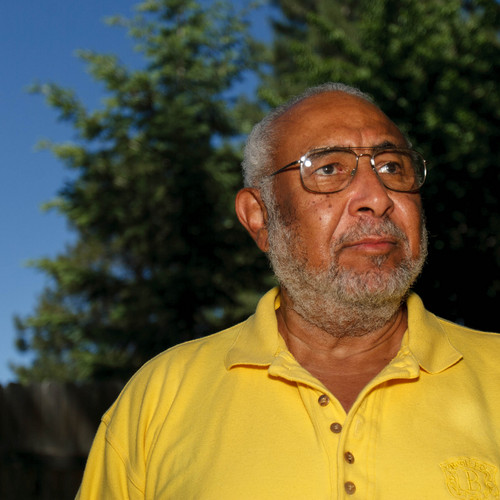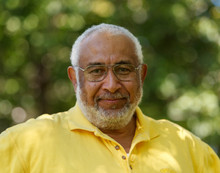This is an archived article that was published on sltrib.com in 2014, and information in the article may be outdated. It is provided only for personal research purposes and may not be reprinted.
Green Flake was in the vanguard company of Mormon pioneers in 1847, driving a wagon into the Salt Lake Valley with LDS prophet Brigham Young, who famously declared Utah to be the right place to build Zion.
But you won't likely see a figure of Flake atop any floats in Thursday's Days of '47 Parade as they glide down the streets of Utah's capital.
That could be because Flake's story is unfamiliar to the vast majority of Mormons. Or because the South Carolina-born convert's narrative is, well, a tad more difficult than the typical pioneer tale: He was black and a slave, who was once donated to the LDS Church as "tithing" after his owner couldn't find a buyer.
Mention of these black members brings up a painful part of the Mormon past — for more than a century blacks were barred from being ordained to the faith's all-male priesthood, and black women were denied access to temple rituals as well. That didn't end until 1978.
Omitting Flake and more than 50 other black pioneers from the heroic recounting of the massive LDS trek across the Plains is not just an oversight, say Mormon historians and members, it is a travesty.
"If we don't celebrate our full history, we are actually celebrating a lie," says Tamu Smith, co-author with Zandra Vranes of "Diary of Two Mad Black Mormons." "We know that we were there, so when people leave us out on purpose, they are not celebrating their own history."
Accounts of black pioneers, argue Smith and Vranes, should be as well-known inside the 15 million-member Church of Jesus Christ of Latter-day Saints as yarns of Young, Mary Fielding Smith (a widow who reportedly healed her dying oxen) and the Willie and Martin handcart companies (many members of which lost their lives along the way).
"Our stories need to be told over and over and over just like the other ones," Vranes says. "When we tell people that Green Flake was right there when Brigham Young said, 'This is the place,' they don't believe us."
—
Persecution within and without • Vranes and Smith hope a new book by Mormon scholar Russell Stevenson, "For the Cause of Righteousness: A Global History of Blacks and Mormonism, 1830-2013," scheduled to be released by Kofford Books in the fall, will spread awareness of black pioneers more widely and provide historical support for what they've been saying for years.
Stevenson, who will begin a doctoral program at Michigan State University this fall, offers new details about the lives of black Mormons, some known, others new.
In addition to pioneers such as Flake, his book looks at later trailblazing black Latter-day Saints including the following:
• Len Hope, who joined the LDS Church in 1913 and found support from his fellow Alabama Mormons as they together suffered persecution at Southern hands.
• William P. Daniels, a black member in South Africa in the 1920s, who established his family as a "study group," and a few years later, that unit grew into "The Branch of Love," with Daniels as a branch president without the priesthood.
• Wynetta Martin, who joined in 1966 and by 1970 became the first black woman in the Mormon Tabernacle Choir.
• Three Ghanaians (Raphael Abraham F. Mensah, Joseph William Johnson and Rebecca Mould), who became acquainted with Mormon literature in the 1960s and drew up a constitution for their "official" Mormon church in 1969 (with Mould as one of their apostles) without approval from church headquarters.
• The Genesis Group — organized in 1971 with leaders Ruffin Bridgeforth, Darius Gray and Eugene Orr — which created a place for black Mormons to find support.
"I hope my book can prompt all of us — but especially white Latter-day Saints," Stevenson says, "to ask hard questions about our racial assumptions."
Black Mormon pioneers were "doubly Mormon — if 19th-century Mormon identity was defined in large measure through persecution," explains Max Mueller, who, using the LDS Church as a case study, just finished a dissertation at Harvard on the relationship between race and religion in that time period.
"Black Mormons were persecuted along with white saints," Mueller writes in an email from Boston, "but their fellow brethren also excluded them from full participation in the religious culture to which intrepid pioneers like Elijah Abel and Jane Manning James dedicated their lives."
Thus, accounts of the earliest black Mormons are among the most wrenching.
Flake, for example, joined the faith in 1844 along with his white owners, James and Agnes Flake (to whom he had been given as a wedding present), Stevenson says.
James Flake died in a farming accident in 1850, leaving Agnes a widow, he notes. "According to Agnes' son, she left behind Flake as an offering to the church and moved to California but only after a futile effort to sell him to other Mormons in the territory."
In 1854, Young gave Flake his freedom. Flake remained a devout Mormon for the rest of his life. He is listed as a "servant" on the monument at This Is the Place Heritage Park in Salt Lake City's eastern foothills.
"Green Flake found himself compelled to live out the paradox that was the black Mormon experience," Stevenson says, "a vision of a hopeful, universal gospel at odds with a telestial reality that the white Mormon community failed to transcend."
He is glad that Latter-day Saints are now recovering Flake's story, but he finds it "as tragic as it is hopeful."
—
A ready and willing Abel • What about Elijah Abel, who was ordained to the LDS priesthood by Mormon founder Joseph Smith in 1836, and soon rose to the office of Seventy and became one of the leading elders of the church at the time?
Abel served at least four Mormon missions and contributed generously to the building of the Salt Lake Temple, but was never allowed inside for its sacred rituals.
"It is tempting to partition Abel off from mainstream Mormon history as a token black man who happened to hold the priesthood," Stevenson says. "But if you want to understand LDS history, Elijah Abel is as representative as any other early white Latter-day Saint."
Not to be forgotten was Jane Manning James, a freeborn black woman who converted to Mormonism in 1839, traveled West with the Saints and tried repeatedly to be allowed into an LDS temple.
James was "sealed" to founder Smith and his wife Emma as a "servant" and, then, posthumously to her own children.
"Our stories are just as inspiring as all the other ones," Vranes says. "How do we tell the story about Eliza Lyman almost dying on the trail and leave out the part about how a black woman gave Eliza half her flour? Saved her life?"
White Mormon feminists almost "deify Eliza R. Snow," an early convert, poet and longtime female leader in the church, Vranes says, but Snow held racist views just like her contemporaries.
In one of Snow's poems, she suggests that "the Negro people are cursed," Vranes says. "So some group's heroes are not everyone's heroes."
Maybe one day, she says, Mormon feminists will understand why "I don't necessarily want a silhouette of Eliza Snow on my T-shirt."
But the real history of LDS blacks also reveals how unusual Mormonism was, Vranes and Smith say.
Abel not only worshipped alongside white Mormons, but also preached to them and led them at a time when most black and white Americans were not allowed in the same congregation. James addressed the mostly white, all-women Relief Society, a feat almost unheard of in the rest of the nation.
Black people, Smith says, "have always been an important part of Mormon history."
Maybe now that rich past will live in the present.
Twitter:@religiongal





